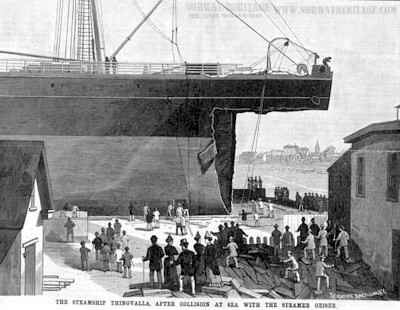The marine disaster - collision between the Thingvalla and Geiser in 1888
Transcribed by B. Solem - January 2005 -
This article and engraving of the S/S Thingvalla was printed in the Scientific American in November 1888. Transcribed by Børge Solem 2005
We give an engraving taken from a photograph showing the condition of the bow of the steamship Thingvalla, when the vessel had been hauled up on the dry dock at Halifax, N. S., after her remarkable collision with the steamer Geiser. The accident took place on the morning of Aug. 14 last, at sea off Sable Island. Both vessels belonged to the same line and were going in opposite directions on their respective routes between New York and Copenhagen.
The story of this collision is one pf the most remarkable in ocean records. Both vessels were under full headway. The night bad been dark and stormy, and it was raining occasionally, but there does not appear to have been any fog or an exceptionally heavy sea. Both steamers were in charge of their first officers, who were old and experienced seamen. On whom the blame rests, neither the officers nor the passengers on either vessel were able to state. Few passengers were on the decks of the steamers at the time of the collision. When the steamers came in view of each other in the grey of the dawn, they were only a few ships' lengths apart, and the crash came in a few minutes. The iron prow of the Thingvalla struck the Geiser amidships on the starboard side, tearing its way half through the side of the unfortunate steamer. Passengers and crew of the ill-fated vessel who was roused by the shock and who escaped injury had not time to realize what had happened. Many who were sleeping on the side of the vessel which was struck were crushed in their berths as they slept, and carried dead and mangled to the bottom of the sea.
For a short time it seemed doubtful whether the Thingvalla had not been so badly injured that she would sink also. Captain Laub, of the Thingvalla, bad an immediate examination made, and the boats were made ready to lower, while the passengers were kept in control. It was soon found that the forward bulkhead of the Thingvalla, though badly crushed and leaking was not destroyed, and the others were all intact. While the forward bulkhead was being repaired, boats had already been lowered for the assistance of the few people who bad escaped from the Geiser.
The ship's carpenters succeeded in bracing up the walls of the bulkhead, but the pressure against them was so great when the ship was moving as to make it exceedingly doubtful whether she could continue her voyage to New York, and in event of a severe storm her condition would be too critical to take any risk. Captain Laub decided to put in at once to Halifax, which was about 180 miles distant, when the Wieland of the Hamburg America Line was sighted, and signals of distress were given. The Wieland bore down upon them, and Captain Albers, her commander, offered to take off all the passengers of the Geiser and the Thingvalla. They were transferred with difficulty; the sea being rough, and the Thingvalla then steamed stern first on to Halifax, while the Wieland proceeded to New York. Second Officer Jørgensen, of the lost steamer Geiser, had a narrow and thrilling escape. In describing his experiences he said: "When the collision occurred, I was sound asleep. I was awakened by the frightful crash, and rolled out of my bunk just as the bow of the Thingvalla crashed its way through the walls of my stateroom, making an enormous hole and blocking the door so I couldn't get out. I grasped the Thingvalla's anchor chain, which was banging over her bow just in front of me, and climbed up to her deck just as the Geiser gave one last lurch and went down out of sight, I with her decks covered with shrieking, despairing people"
I believe there were many others who failed to get out of the cabins at all, for less than seven minutes elapsed from the time the Geiser was struck until she sank. As near as I could judge from a hasty glance, the entire starboard side of the Geiser, from the stern to forward of the mizzenmast, was crushed in, while the Thingvalla's nose was ripped completely off, clear back to the first bulkhead."
The Geiser was a three-masted iron screw steamer, schooner rigged, with square sails on her for foremast. She was built at Copenhagen in 1881, and was 1,993 net and, 2,831 gross tons register. Her engines were 300 horse power, and she was constructed with six water-tight compartments. The vessel was owned by the Thingvalla Steamship Company of Copenhagen. She carried a crew of sixty-seven all told. The vessel was fitted up to accommodate fifty saloon, forty-five second cabin, and 600 steerage passengers, and had recently had new saloon and second cabin fittings put into her, which were of the most handsome and newest description. On leaving this port she bad a cargo of flour, beef, 1eather, lard, 42,066 bushels of corn, forty seven hogsheads of tobacco, and miscellaneous merchandise, valued in round figures at about $150,000. The steamer was I valued at about $250,000, and was partially insured. The Thingvalla is an iron three-masted screw steamer and measures 301 feet over all. She is 1,745 net and 2,524 gross tonnage and her engines are 300 horse power. She was built in Copenhagen in 1874, and is owned by the same company as the Geiser. She is commanded by Captain S. Laub. Both vessels are classed 100 A 1 in Lloyd's Registry in England.
The Thingvalla was repaired at Halifax at a cost of, about $60,000, and arrived a few days ago at New York to take her place again on the line.

